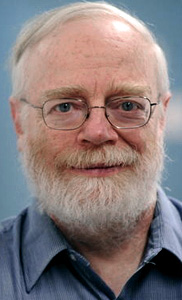

 Mid-January 2012 marked a major inflection point for digital copyright policy in the United States... Yet no one involved with Congressional interaction on either side of the issue believes it has been sidetracked for long, and "Hollywood" and "Silicon Valley" are both plotting their next moves in this high-stakes game to further define the responsibilities and potential liabilities... The resolution of this dispute will determine the ability of Internet services to move to "the cloud"... more
Mid-January 2012 marked a major inflection point for digital copyright policy in the United States... Yet no one involved with Congressional interaction on either side of the issue believes it has been sidetracked for long, and "Hollywood" and "Silicon Valley" are both plotting their next moves in this high-stakes game to further define the responsibilities and potential liabilities... The resolution of this dispute will determine the ability of Internet services to move to "the cloud"... more
 The term "attack surface" is often heard in cybersecurity conversations. It refers to the sum of all possible attack vectors or the vulnerabilities that threat actors can exploit to penetrate a target network or damage an organization somehow. An unused and forgotten subdomain, for instance, can become an attack vector when taken over. Certain categories of companies have very large attack surfaces. Such is the case of streaming media businesses like Netflix and HBO Max. more
The term "attack surface" is often heard in cybersecurity conversations. It refers to the sum of all possible attack vectors or the vulnerabilities that threat actors can exploit to penetrate a target network or damage an organization somehow. An unused and forgotten subdomain, for instance, can become an attack vector when taken over. Certain categories of companies have very large attack surfaces. Such is the case of streaming media businesses like Netflix and HBO Max. more
 After hearing over 350 presentations on IPv6 from IPv6-related events in the US (seven of them), China, Spain, Japan, and Australia, and having had over 3,000 discussions about IPv6 with over a thousand well-informed people in the IPv6 community, I have come to the conclusion that all parties, particularly the press, have done a terrible job of informing people about the bigger picture of IPv6, over the last decade, and that we need to achieve a new consensus that doesn't include so much common wisdom that is simply mythical. There are many others in a position to do this exercise better than I can, and I invite them to make a better list than mine, which follows. more
After hearing over 350 presentations on IPv6 from IPv6-related events in the US (seven of them), China, Spain, Japan, and Australia, and having had over 3,000 discussions about IPv6 with over a thousand well-informed people in the IPv6 community, I have come to the conclusion that all parties, particularly the press, have done a terrible job of informing people about the bigger picture of IPv6, over the last decade, and that we need to achieve a new consensus that doesn't include so much common wisdom that is simply mythical. There are many others in a position to do this exercise better than I can, and I invite them to make a better list than mine, which follows. more
 What economic and social factors are shaping our future needs and expectations for communications systems? This question was the theme of a joint National Science Foundation (NSF) and Organisation for Economic Co Operation and Development (OECD) workshop, held on the 31st January of this year. The approach taken for this workshop was to assemble a group of technologists, economists, industry, regulatory and political actors and ask each of them to consider a small set of specific questions related to a future Internet. Thankfully, this exercise was not just another search for the next "Killer App", nor a design exercise for IP version 7. It was a valuable opportunity to pause and reflect on some of the sins of omission in today's Internet and ask why, and reflect on some of the unintended consequences of the Internet and ask if they were truly unavoidable consequences... more
What economic and social factors are shaping our future needs and expectations for communications systems? This question was the theme of a joint National Science Foundation (NSF) and Organisation for Economic Co Operation and Development (OECD) workshop, held on the 31st January of this year. The approach taken for this workshop was to assemble a group of technologists, economists, industry, regulatory and political actors and ask each of them to consider a small set of specific questions related to a future Internet. Thankfully, this exercise was not just another search for the next "Killer App", nor a design exercise for IP version 7. It was a valuable opportunity to pause and reflect on some of the sins of omission in today's Internet and ask why, and reflect on some of the unintended consequences of the Internet and ask if they were truly unavoidable consequences... more
 In my first CircleID post, I compared the cyberspace to a farmland, which has to be cultivated and developed. I ended by asking: Where is cyberspace? I have asked this same question from many people, many of whom are internet experts. They all said the cyberspace is in the computers, networks, or servers, or the Internet itself. I agree with these cyberspace ideas. In addition, my opinion is a bit different. more
In my first CircleID post, I compared the cyberspace to a farmland, which has to be cultivated and developed. I ended by asking: Where is cyberspace? I have asked this same question from many people, many of whom are internet experts. They all said the cyberspace is in the computers, networks, or servers, or the Internet itself. I agree with these cyberspace ideas. In addition, my opinion is a bit different. more
 Many communications networks are constructed for a single form of communication, and are ill suited to being used for any other form. Although the Internet is also a specialized network in terms of supporting digital communications, its relatively unique flexibility lies in its ability to digitally encode a very diverse set of communications formats, and then support their interaction over the Internet. In this way many communications networks can be mapped into an Internet application and in so doing become just another distributed application overlayed on the Internet. From this admittedly Internet-centric perspective, voice is just another Internet application. And for the growing population of Voice over IP (VoIP) users, this is indeed the case... more
Many communications networks are constructed for a single form of communication, and are ill suited to being used for any other form. Although the Internet is also a specialized network in terms of supporting digital communications, its relatively unique flexibility lies in its ability to digitally encode a very diverse set of communications formats, and then support their interaction over the Internet. In this way many communications networks can be mapped into an Internet application and in so doing become just another distributed application overlayed on the Internet. From this admittedly Internet-centric perspective, voice is just another Internet application. And for the growing population of Voice over IP (VoIP) users, this is indeed the case... more
 Recently I was asked by a customer how they can easily set up rollback capabilities on the endpoints in their corporate network. They had seen the marketing hype by various security technology providers that their products included rollback capabilities they could utilize if/when one of their workstations or servers was infected by malware. Having gotten this question more than once, I thought it would be a good subject to share with a broader audience. more
Recently I was asked by a customer how they can easily set up rollback capabilities on the endpoints in their corporate network. They had seen the marketing hype by various security technology providers that their products included rollback capabilities they could utilize if/when one of their workstations or servers was infected by malware. Having gotten this question more than once, I thought it would be a good subject to share with a broader audience. more
 An article written by Paul Wilson, Director General of Asia Pacific Network Information Centre (APNIC), and Geoff Huston, Senior Internet Research Scientist at APNIC. "In recent months proposals have been made for the introduction of competition into the system of allocation of IP addresses. In particular, calls have been made for new IP address registries to be established which would compete with the existing Regional Internet address Registries (RIRs). Specific proposals have been made by Houlin Zhao of the ITU-T and by Milton Mueller of the Internet Governance Project, both of which propose that the ITU itself could establish such a registry group, operating as a collection of national registries." ...It would appear that part of the rationale for these proposals lies in the expectation that the introduction of competition would naturally lead to outcomes of "better" or "more efficient" services the address distribution function. This article is a commentary on this expectation, looking at the relationship between a competitive supply framework and the role of address distribution, and offering some perspective on the potential outcomes that may be associated with such a scenario for IP addresses, or indeed for network addresses in general. more
An article written by Paul Wilson, Director General of Asia Pacific Network Information Centre (APNIC), and Geoff Huston, Senior Internet Research Scientist at APNIC. "In recent months proposals have been made for the introduction of competition into the system of allocation of IP addresses. In particular, calls have been made for new IP address registries to be established which would compete with the existing Regional Internet address Registries (RIRs). Specific proposals have been made by Houlin Zhao of the ITU-T and by Milton Mueller of the Internet Governance Project, both of which propose that the ITU itself could establish such a registry group, operating as a collection of national registries." ...It would appear that part of the rationale for these proposals lies in the expectation that the introduction of competition would naturally lead to outcomes of "better" or "more efficient" services the address distribution function. This article is a commentary on this expectation, looking at the relationship between a competitive supply framework and the role of address distribution, and offering some perspective on the potential outcomes that may be associated with such a scenario for IP addresses, or indeed for network addresses in general. more
 Jeff Pulver proposed an interesting idea called IPv6 Day... In geeks term, we call this a 'flag day'. The last time we have a flag day was 1st Jan 1983 when Internet moved from NCP (Network Control Protocol) to IPv4. So why not do it for IPv6? more
Jeff Pulver proposed an interesting idea called IPv6 Day... In geeks term, we call this a 'flag day'. The last time we have a flag day was 1st Jan 1983 when Internet moved from NCP (Network Control Protocol) to IPv4. So why not do it for IPv6? more
Many media sources have reported outages in Iranian mobile networks and Internet services in the wake of Friday's controversial elections. We took a look at the state of Iranian Internet transit, as seen in the aggregated global routing tables, and found that the story is not as clear-cut as has been reported. There's no question that something large happened in the Iranian telecom space, and that the timing aligns with the close of voting and the emerging controversy... more
 This is a special two-part series article providing a distinct and critical perspective on Internet Protocol Version 6 (IPv6) and the underlying realities of its deployment. The first part gives a closer look at how IPv6 came about and the second part exposes the myths.
This is a special two-part series article providing a distinct and critical perspective on Internet Protocol Version 6 (IPv6) and the underlying realities of its deployment. The first part gives a closer look at how IPv6 came about and the second part exposes the myths.
In January 1983, the Advanced Research Projects Agency Network (ARPANET) experienced a "flag day," and the Network Control Protocol, NCP, was turned off, and TCP/IP was turned on. Although there are, no doubt, some who would like to see a similar flag day where the world turns off its use of IPv4 and switches over to IPv6, such a scenario is a wild-eyed fantasy. Obviously, the Internet is now way too big for coordinated flag days. The transition of IPv6 into a mainstream deployed technology for the global Internet will take some years, and for many there is still a lingering doubt that it will happen at all. more
The shift from IPv4 to IPv6 has been a protracted and complex process, raising questions about why this transition has been so sluggish despite the depletion of IPv4 addresses more than a decade ago. more
 The Wall Street Journal reported that AT&T saw wireless networks about to drown under a deluge of data. To see YouTube content uploaded form an iPhone or Slingbox rerouting a favourite television program to your smart phone gives mobile network operators the shivers. Skype over 3G in the meantime gives sleepless nights, not because of surging megabyte floods but due to nightmares of considerable voice and roaming revenues washing away. Not easy to plan and engineer "managed transitions" under those circumstances. more
The Wall Street Journal reported that AT&T saw wireless networks about to drown under a deluge of data. To see YouTube content uploaded form an iPhone or Slingbox rerouting a favourite television program to your smart phone gives mobile network operators the shivers. Skype over 3G in the meantime gives sleepless nights, not because of surging megabyte floods but due to nightmares of considerable voice and roaming revenues washing away. Not easy to plan and engineer "managed transitions" under those circumstances. more
 Brooks is famous for many things. Many people know him best as the author of The Mythical Man-Month, his musings on software engineering and why it's so very hard. Some of his prescriptions seem quaint today -- no one these days would print out documentation on microfiche every night to distribute to developers -- but his observations about the problems of development remain spot-on. But he did so much more. more
Brooks is famous for many things. Many people know him best as the author of The Mythical Man-Month, his musings on software engineering and why it's so very hard. Some of his prescriptions seem quaint today -- no one these days would print out documentation on microfiche every night to distribute to developers -- but his observations about the problems of development remain spot-on. But he did so much more. more
 Nokia Deepfield is another company that works in the background on the web, and that analyzes data traffic patterns for the big ISPs. Their June 4 report on web traffic reports about the same thing we're hearing from most large ISPs -- the volume of web traffic suddenly shot up since the onset of the pandemic. Nokia Deepfield says that the increase in traffic has settled in at about a 25% increase over pre-COVID levels. more
Nokia Deepfield is another company that works in the background on the web, and that analyzes data traffic patterns for the big ISPs. Their June 4 report on web traffic reports about the same thing we're hearing from most large ISPs -- the volume of web traffic suddenly shot up since the onset of the pandemic. Nokia Deepfield says that the increase in traffic has settled in at about a 25% increase over pre-COVID levels. more